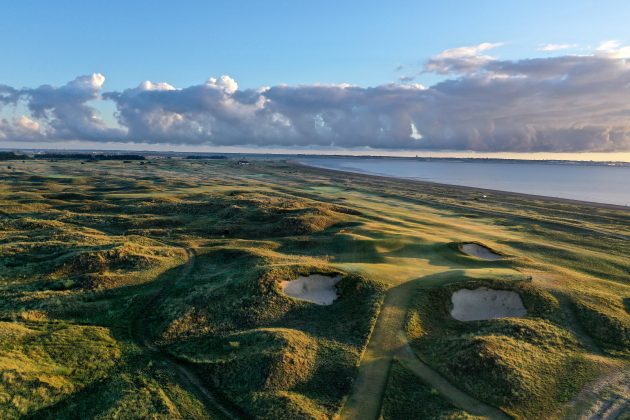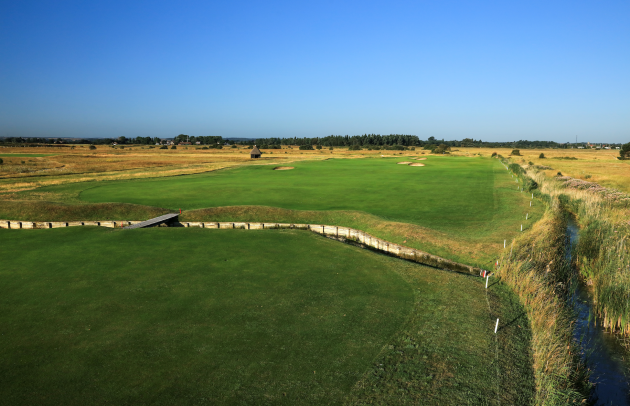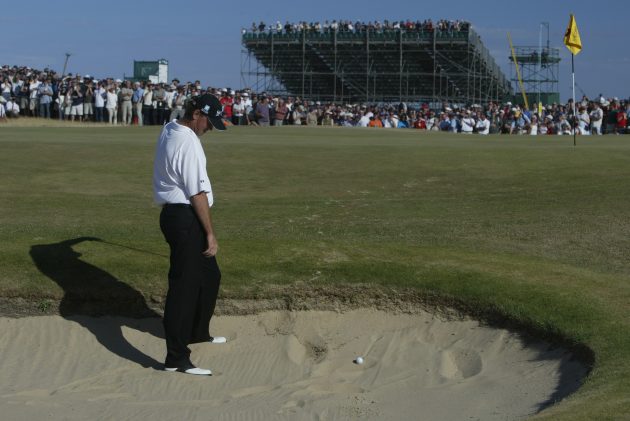Open Championship Vlog - Royal St George's Preview
Jeremy Ellwood and Neil Tappin play six key holes at Royal St George’s that could define the 149th Open Championship

Jeremy Ellwood and Neil Tappin play six key holes at Royal St George’s that could define the 149th Open Championship
Open Championship Vlog - Royal St George's Preview
Royal St George’s in Sandwich stands out in several ways. It was the first course outside Scotland to host The Open in 1894; it is the only current Open rota venue in the south of England; and it plays over the most rumpled fairways of any links on which the world’s best compete for the Claret Jug.
It’s true to say it probably provides the most scope for unlucky bounces, something that has not always sat well with some of the biggest names in golf, with some quite loud anti-voices to be heard both before and after 2003’s surprise winner, Ben Curtis, had been crowned.
Yes, a couple of blind shots remain off the 4th and 7th tees. And yes, it has thrown up other unexpected champions in Bill Rogers (1981) and Darren Clarke, whose last Major top-ten had come a decade before his 2011 victory. But these ‘anomalies’ are countered by J.H. Taylor, Harry Vardon (twice), Walter Hagen (twice), Henry Cotton and Greg Norman.
Those who have played here know it does pose a slightly different test that demands pinpoint accuracy into several greens, many of which are larger this time round, and a degree of patience to accept the rough with the smooth. It is also a links that constantly twists and turns through the dunes. No two consecutive holes ever play in exactly the same direction.
Recent history suggests that if ever there were a venue on which to back an outsider, this would be it, but equally, it could well be one of golf’s current big hitters who prevails.
Subscribe to the Golf Monthly newsletter to stay up to date with all the latest tour news, equipment news, reviews, head-to-heads and buyer’s guides from our team of experienced experts.
Here, we take a look at six key holes, one heading out and three down the stretch, which could have a say in who comes out on top…
1st Hole
It's not the longest hole at 442 yards, which is no big deal for the pros these days, but if it's into the wind and the rough is as we expect then it is set to be a fairly daunting prospect - especially when you add in 1st tee nerves to the equation.
Tiger Woods infamously begun his Championship in 2003 with a triple-bogey 7 here.
There's a deep hollow on the right known as 'the kitchen' where a lot of the members end up although most of the tour pros will not be bothered by that.
The second shot into the 1st is fairly intimidating. Staring you in the face is the big bunker that lies directly in line with the flag, just short of the green.
There are two other deep bunkers short and left that you definitely need to avoid if you're hoping to start with a par.
There's also run-off areas short and long so finding the green is tricky, especially if you're coming in from the rough.
4th Hole

The challenges here are slightly different for the world’s best and average club golfers. The vast bunker that stares back at you off the tee and obscures the fairway is unlikely to trouble them, as it’s only a 240-yard carry off the back tees. That said, in 1981, Rogers did make reference to the 4th as one of the key holes. “The Himalaya bunker is such a challenge,” Rogers reflected. “The hole in itself is hard enough, but you’re visually very challenged on that hole.”
When I played a preview round here off the back tees in May with Neil Tappin, the height of that bunker made the carry too much for me, and we had a little fun experimenting with the shot back out. But if a 240-yard carry is of little consequence to today’s top players other than in extreme conditions, and that bunker is little more than a visual challenge, what else makes the hole so difficult?
Playing it as a par 4 now possibly has some bearing on things psychologically (it was still a par 5 in 2003), but perhaps today’s real challenges lie up at the extraordinary green. The many different slopes and levels will not only see slightly misdirected shots roll off the surface, but also lead to some of the most challenging two-putts on the links as players try to work out the contours and steep changes in elevation between sectors.
There are no bunkers at the green, and only a couple more further up the hole after the large tee-shot trap, with a small pot bunker on the left at about 290 yards. But the ideal angle in is from the right, so the Himalaya bunker will be the line off the tee for most.
There were more doubles and ‘others’ here than on any other hole in 2011, with a number of three-putts undoubtedly contributing. The shorter the club for your approach, the more chance you have of finding the correct part of the green. In 2011, champion Clarke recorded one of each from birdie through to double-bogey.
7th Hole

This is the first par 5 and it takes you right down to the sea road and the beach.
It's a dogleg right-to-left and the big hitters will have a massive advantage here as they'll be able to cut off some of the corner - although anything leaked could find the two pot bunkers down the right.
It's an intimidating drive with bunkers either side of the fairway so you've got to be very disciplined in picking a line otherwise a missed fairway will be on the cards.
A good drive offers up a golden birdie chance for the best players in the world.
The green is 38 yards from front-to-back so there's plenty of room for them on the dance floor if the bunkers to the right can be avoided.
There are not many birdie opportunities on the golf course and with the 7th being one of just two par 5s, players will be desperate to make a 3 or 4 here.
14th Hole

You might be excused for thinking ‘what’s the problem here?’ A 547-yard, virtually dead-straight par 5 on firm links terrain is nothing in the modern era, yet this is still a hole that many players fear, especially if the wind is off the left. OOB lies in wait for the entire length of the hole, not very far from the fairway cut or the green.
Par 5s of this length rarely play to an above-par average these days, but in the 2011 Open, the average throughout the week was 5.07, with just one eagle recorded compared with 19 on the longer 7th on the front nine.
When Neil and I played, the wind was indeed off the left, and I duly despatched a couple of balls on to neighbouring Prince’s before finally getting one to come to rest on the fairway.
But one of the real reasons the top pros don’t make mincemeat of this hole is the ‘Suez Canal’, a stream that crosses the fairway at about 330 yards off the tips. This is too far for most to risk attempting the carry other than when strongly downwind, but just the right distance to force them to lay back and take it out of play. It’s at least 200 yards to the front of the green from the tee-side of the burn, but most will lay back further than that.
The 240- to 250-yard approach is then quite a scary prospect, with the green set so close to OOB. Those who choose to lay up will find there are two central bunkers to avoid there, too. The better angle in is from the right, but there is relatively little room between those two bunkers and the OOB line.
This hole plays with your mind, too. In 1993, feeling he had to play more aggressively, Bernhard Langer took driver in the final round having adopted a more cautious strategy before. He promptly drove it OOB.
16th Hole

The shortest of the four par 3s certainly looks the most innocuous on the scorecard, for 162 yards requires very little club for most top pros these days in normal conditions. But even though it does play the easiest of the one-shotters, it still averaged over par in 2011.
The four bunkers short of the green are really far enough short not to pose much of a threat, other than on serious misstrikes or misclubbings on windy days when the pin is at the front. But the shortest of this quartet, in particular, does serve to obscure part of the green, so when the pin is on the left, you won’t be able to see the foot of the flag.
This was the case when Neil and I played, and there is certainly something about not being able to see the hole that adds to the challenge for average golfers. That shouldn’t be the case for top pros, though, who work to precise yardages and landing spots.
The green itself is not particularly small for a hole of this length, but it is the contouring on the right side, in particular, that causes the biggest issues. See Thomas Bjorn’s famous moment here in 2003.
Anything short or right is swept away at speed into the waiting bunker, which is not in itself a particularly tricky one, other than the dangers of that same slope if you try to be too cute with the ensuing splash shot.
For the top pros challenging for the title, maybe it is the point at which it comes in the round, seemingly offering the only real respite, on paper at least, down a demanding stretch from the 14th tee to the final putt. But it still needs to be treated with due respect, and even minor miscues can see you fighting to save par on a hole that seems to offer your best chance on the run for home.
18th Hole

The finale at Royal St George’s shares some symmetry with the closing hole at Royal Troon, boasting a similar number of fairway bunkers to keep players on their toes. As with so many holes like this, length is perhaps not the issue it once was other than when playing into the wind, and indeed, if the wind is the other way round and conditions are firm and running, some players could be hitting very short shots into the green.
The challenge is to guide your ball down the fairway and stay out of the two shorter bunkers on the left – if caution is being exercised off the tee – or find the narrow gap between the bunkers on the right and left if adopting a more aggressive approach.
Wherever you’re coming in from, though, the 49-yard-long green demands both attention and accuracy. Spots to avoid include the deep front-right bunker and the hollow on the left, where there will often be enough pace on the ball to take it beyond the fringe cut into the trickier rough.
In still conditions, 450 yards may no longer be the fearsome challenge it once was, but there is much that can still go wrong here in the quest for an Open-winning par. Clarke couldn’t manage it in 2011, when the hole played third-hardest on the course to an average of 4.33, but thankfully, he didn’t need to!
And if you require birdie to win, the stats from last time round suggest you will have just a seven per cent chance of achieving that goal, with only 32 from 453 attempts.